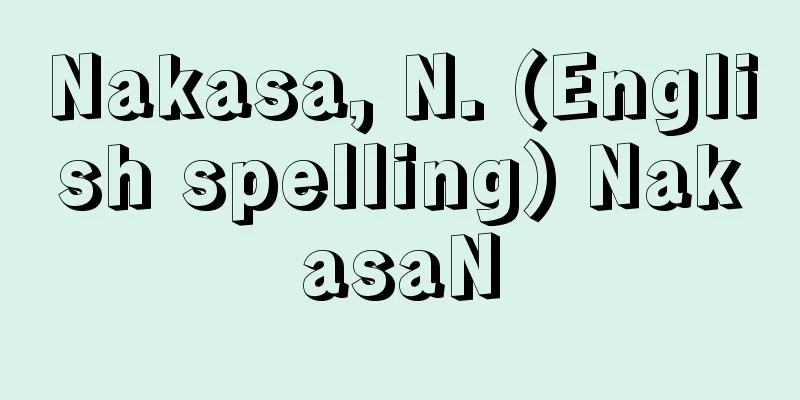National Pension - kokuminnenkin

|
In Japan's public pension system, a system that provides a basic pension common to all citizens as well as a special pension system for the self-employed. It is abbreviated as "Kokunen." [Yasuhiko Yamazaki November 13, 2020] HistoryThe National Pension was enacted based on the National Pension Act of 1959 (Showa 34), and came into full effect in April 1961. The National Pension was launched to target self-employed workers in agriculture, forestry, fisheries, and other sectors, as well as workers at small businesses, who were not covered by the Employees' Pension Insurance and Mutual Aid Pension Insurance, and this resulted in the realization of a pension system for all citizens. However, the application of the pension to wives of subscribers to employee pension schemes (category 2 insured persons under the National Pension) and students aged 20 or over was made voluntary as an exception, and was left as an issue for the future. The main points of subsequent revisions are listed below. (1) 1985 Amendment: Unification of the pension system through the introduction of a basic pension common to all citizens, adjustment of benefit levels and mitigation of future increases in the burden, establishment of pension rights for women by making the spouses of employees' pension subscribers compulsory enrollment in the National Pension System, improvement of disability pensions through the provision of basic disability pensions to those who became disabled before the age of 20, and adjustment of concurrent payments based on the principle of one pension per person. (2) 1989 Amendment: Compulsory application to students aged 20 or over, and establishment of a voluntary National Pension Fund. (3) 2000 Amendment: The revision of pension amounts after the age of 65 was unified into a price indexation system, and a half-price exemption system for insurance premiums and a special exemption system for students were introduced. (4) 2004 Amendment: Increase in the government's share of the basic pension fund, introduction of a macroeconomic sliding system that fixes the final insurance premium and automatically adjusts the benefit level, and introduction of a multi-stage insurance premium exemption system. (5) 2012 Amendment: The eligibility period for receiving basic old-age pensions, etc., was shortened from 25 years to 10 years, the national treasury's share of the basic pension burden was made permanent at half, and basic survivor's pensions were provided to single-father households. (6) 2016 Amendment: Exemption from insurance premiums for the prenatal and postnatal period for Category 1 insured persons and review of pension amount adjustment rules. (7) 2020 (Reiwa 2) Amendment: The National Pension Booklet is replaced by the Basic Pension Number Notification Card, and unmarried parents are added to the criteria for full exemption from paying national pension insurance premiums (eligible for full exemption from payment), just like widows. [Yasuhiko Yamazaki November 13, 2020] Insured personNational pension insured persons are divided into three categories. (1) Type 1 insured person: A person aged 20 to 60 who resides in Japan and is not a type 2 or 3 insured person. [Yasuhiko Yamazaki November 13, 2020] Overview of benefitsIn addition to the basic old-age pension, basic disability pension, and basic survivor's pension that are common to all insured persons, there are also additional pensions, widow's pensions, lump-sum death benefits, and lump-sum withdrawal benefits that are exclusive to Type 1 insured persons. (1) Basic Old-Age Pension In principle, it is paid to those who have 10 or more years of eligibility period when they reach the age of 65. The eligibility period is the sum of the period during which insurance premiums were paid, the period during which insurance premiums were exempted, and the period eligible for inclusion. The period during which insurance premiums were paid includes the period of membership in the employee pension plan. The period eligible for inclusion is a "blank period" that is included in the eligibility period for the basic old-age pension but is not included in the basis for calculating the pension amount, such as the period of living abroad, the period during which the spouse or student of an employee pension plan member did not voluntarily join the plan when membership was optional, etc. The age at which the pension begins can be selected to be paid early (reduced) between the ages of 60 and 65, or deferred (increased) after the age of 66. The pension amount (annual amount) is a flat rate of 781,700 yen (2020 fiscal year), but if there are periods during which insurance premiums were not paid or exempted during the 40 years from the age of 20 to 60, the amount will be reduced according to the period. However, for those who were 20 years of age or older when the National Pension System was launched in April 1961, there are measures to shorten the period depending on age. (2) Disability Basic Pension: This pension is paid to those who were insured on the first day of medical examination for the injury or illness that caused the disability, and who have paid insurance premiums and been exempt from insurance premiums for at least two-thirds of their insured period before the first day of medical examination, and who have a first or second-grade disability on the day of disability certification. The annual pension amount is 977,125 yen for first-grade disability and 781,700 yen for second-grade disability (both for the fiscal year 2020). In addition, disability basic pension is paid to those who were under 20 years old on the first day of medical examination, provided that their income is below a certain amount, if they become disabled after turning 20. (3) Survivor's Basic Pension: When a National Pension insured person whose combined period of insurance premium payment and exemption is more than two-thirds of the insured period, a beneficiary of a basic old-age pension, or a person who has met the eligibility period for receiving a basic old-age pension dies, this pension is paid to the spouse with a child or unmarried child who was supported by the deceased. A child is a child up to the last day of the year in which the person turns 18, or a child under the age of 20 who has a first or second degree disability. The annual pension amount is 1,006,600 yen (2020 fiscal year) for a spouse and one child, with an additional amount for each child after the second child. (4) Independent benefits for Type 1 insured persons The supplementary pension is an additional benefit on top of the basic pension under the voluntary enrollment system, and is paid according to the period for which supplementary insurance premiums have been paid. A widow's pension is paid to the wife from age 60 to age 65 when a husband who fulfilled the eligibility period for the basic old-age pension only through his enrollment period as a Type 1 insured person dies without receiving the pension. A lump-sum death benefit is paid to the surviving family members when a person who has paid insurance premiums as a Type 1 insured person for three years or more dies without receiving either the basic old-age pension or the basic disability pension, and the surviving family members are not eligible to receive the basic survivor's pension. A lump-sum withdrawal benefit is paid to a foreigner who has paid insurance premiums as a Type 1 insured person for six months or more and is not eligible to receive a pension, when he returns to his home country. [Yasuhiko Yamazaki November 13, 2020] Cost burdenThe annual basic pension benefit cost is shared among all insured persons (insurance premium payers for Category 1 insured persons, and those aged 20 to 60 for Category 2 insured persons). Specifically, Category 1 insured persons pay insurance premiums individually, while the premiums for Category 2 and Category 3 insured persons are paid in a lump sum as basic pension contributions from the Employees' Pension Insurance. The national treasury's share is half of the basic pension benefit cost. The monthly premium for the National Pension System for Type 1 insured persons is 16,540 yen (2020). This premium includes not only the basic pension benefit portion, but also the portion that goes to Type 1 insured persons' own benefits and savings. The monthly premium for the voluntary supplementary pension is 400 yen. There are systems for statutory exemption, application exemption, and maternity and postpartum period exemption for Type 1 insured persons, and they are exempt from paying the premium. Statutory exemptions apply to those who receive livelihood assistance under the Public Assistance Act and those who are eligible to receive a basic disability pension. Application exemptions apply to those who have no income, those who receive assistance other than public assistance under the Public Assistance Act, and those who are otherwise deemed to have difficulty paying the premium. Upon application, they may be exempt from paying the full amount, three-quarters, one-half, or one-quarter of the premium. They are exempt from paying the full amount of the premium during the prenatal and postnatal period (four months from the month before the expected date of delivery). In addition, there is a special payment system for students and a deferral system for insured persons under 50 years old. For students, if their income is below a certain amount, and for insured persons under 50 years old, if their income is below a certain amount, payment of insurance premiums can be deferred upon application. The period during which the insured person was exempt from insurance premiums is counted as the period of eligibility for pension benefits, and when calculating the amount of the basic old-age pension, the person will receive benefits equivalent to the national treasury burden for periods of statutory exemption and application exemption, and the same amount as a person who pays the full amount of insurance premiums for the period before and after childbirth. On the other hand, the period during which the student payment special exemption and deferral of payment of insurance premiums were received is not reflected in the amount of the basic old-age pension, and the amount will be reduced by that amount. For the basic disability pension and basic survivor's pension, the full amount will be paid without reduction, even if there was a period during which the person was exempt from insurance premiums. The insurance premiums for the periods during which the person was exempt from insurance premiums can only be paid in arrears for up to 10 years. In addition, with a view to eliminating the situation of people without pensions or receiving low pensions due to non-payment of insurance premiums, those who have a certain level of financial ability and are not eligible for exemption from insurance premiums, but who have been in arrears on their premiums for a long time, will be sent a final notice taking into account their income and payment status, etc., and those who still do not voluntarily pay will be subject to collection procedures (seizure of property). [Yasuhiko Yamazaki November 13, 2020] Mizuho Research Institute (ed.), Illustrated Guide to the Pension System, 6th Edition (2015, Toyo Keizai Inc.) ▽ Yoshihara Kenji and Hata Mitsuru (ed.), History of Japan's Public Pension System -- 70 Years After the War and Half a Century of Universal Pensions (2016, Chuohoki Publishing) ▽ National Pension Law Overview, April 2018 Edition (2018, Social Insurance Research Institute) ▽ Commentary on the Amendments to the Pension System Strengthening Act (2020, Social Insurance Research Institute) ▽ Social Insurance Guide, Pension Guide, National Pension Handbook, various years' editions (Social Insurance Research Institute) ▽ Insurance and Pension Trends, various years' editions, compiled and published by the Health, Labor and Welfare Statistics Association [Reference items] | | | | | | |Source: Shogakukan Encyclopedia Nipponica About Encyclopedia Nipponica Information | Legend |
|
日本の公的年金制度のなかで、全国民共通の基礎年金とともに、自営業者などに対する独自の年金を支給する制度。国年(こくねん)と略称される。 [山崎泰彦 2020年11月13日] 沿革国民年金は、1959年(昭和34)の国民年金法に基づいて制定され、1961年4月から全面的に施行された。国民年金は、厚生年金保険および共済年金の対象外であった農林漁業などの自営業者や零細事業所の労働者を対象として発足し、これにより国民皆年金体制が実現した。ただし、被用者年金(国民年金の第2号被保険者)の加入者の妻と20歳以上の学生への適用については、例外的に任意加入とされ、将来の課題として残された。以下はその後の改正の主要事項である。 (1)1985年改正 全国民共通の基礎年金の導入による年金制度の一元化、給付水準の適正化と将来の負担増の緩和、被用者年金加入者の配偶者に対する国民年金強制加入による女性の年金権の確立、20歳前に障害者となった者などに対する障害基礎年金の支給などによる障害年金の改善、1人1年金の原則による併給調整。 (2)1989年(平成1)改正 20歳以上の学生への強制適用、任意加入制の国民年金基金の創設。 (3)2000年(平成12)改正 65歳以後の年金額改定の物価スライド方式への一本化、保険料半額免除制度と学生の保険料納付特例制度の導入。 (4)2004年改正 基礎年金の国庫負担割合の引上げ、最終保険料を固定したうえで給付水準を自動調整するマクロ経済スライド方式の導入、保険料の多段階免除制度の導入。 (5)2012年改正 老齢基礎年金等の受給資格期間の25年から10年への短縮、基礎年金国庫負担割合2分の1の恒久化、父子世帯に対する遺族基礎年金の支給。 (6)2016年改正 第1号被保険者の産前産後期間の保険料免除、年金額改定ルールの見直し。 (7)2020年(令和2)改正 国民年金手帳から基礎年金番号通知書への切替え、未婚のひとり親等を寡婦と同様に国民年金保険料の申請全額免除基準等(支払い全額免除の対象)に追加。 [山崎泰彦 2020年11月13日] 被保険者国民年金の被保険者は3区分されている。 (1)第1号被保険者 日本国内に住所のある20歳以上60歳未満の者であって、以下の第2号・第3号被保険者でない者 [山崎泰彦 2020年11月13日] 給付の概要全被保険者共通の老齢基礎年金、障害基礎年金、遺族基礎年金のほかに、第1号被保険者のみの独自給付である付加年金、寡婦年金、死亡一時金、脱退一時金がある。 (1)老齢基礎年金 原則として、受給資格期間が10年以上ある者が65歳に達したときに支給される。受給資格期間は、保険料納付済期間、保険料免除期間、合算対象期間を合計した期間である。保険料納付済期間には被用者年金の加入期間を含む。合算対象期間とは、老齢基礎年金の受給資格期間には算入するが年金額の計算の基礎には含めない「カラ期間」で、外国に居住していた期間、被用者年金加入者の配偶者や学生であって加入が任意とされていたときに任意加入しなかった期間などである。支給開始年齢については、60歳以上65歳前での繰上げ(減額)支給、66歳以後での繰下げ(増額)支給を選択することもできる。年金額(年額)は、一律に78万1700円(2020年度)であるが、20歳から60歳になるまでの40年間に保険料の未納期間や免除期間があれば、その期間に応じて減額される。ただし、国民年金が発足した1961年4月に20歳以上であった者には、年齢に応じた期間短縮措置がある。 (2)障害基礎年金 障害の原因となった傷病の初診日において被保険者であった者などで、初診日前に保険料納付済期間と保険料免除期間をあわせた期間が被保険者期間の3分の2以上あり、かつ障害認定日に1級または2級障害の状態のある者に支給される。年金額(年額)は、1級障害97万7125円、2級障害78万1700円である(いずれも2020年度)。その他、初診日において20歳未満であった者にも、20歳以後障害の状態にあれば、本人の所得が一定額以下であることを条件として、障害基礎年金が支給される。 (3)遺族基礎年金 国民年金の被保険者で保険料納付済期間と保険料免除期間をあわせた期間が被保険者期間の3分の2以上ある者、老齢基礎年金の受給権者、老齢基礎年金の受給資格期間を満たした者などが死亡したとき、その者によって生計を維持していた子のある配偶者または婚姻していない子に支給される。子とは、18歳到達年度の末日までの子または20歳未満であって1級・2級の障害の状態にある子である。年金額(年額)は、配偶者と子1人の場合100万6600円(2020年度)で、2人目以降の子についての加算がある。 (4)第1号被保険者の独自給付 付加年金は任意加入制の基礎年金の上乗せ給付で、付加保険料の納付済期間に応じて支給される。寡婦年金は、第1号被保険者としての加入期間のみで老齢基礎年金の受給資格期間を満たしている夫が年金を受けないで死亡したとき、妻に60歳から65歳になるまでの間支給される。死亡一時金は、第1号被保険者として保険料を3年以上納めた者が、老齢基礎年金、障害基礎年金のいずれをも受けないで死亡し、その遺族が遺族基礎年金を受給できない場合に、遺族に支給される。脱退一時金は、第1号被保険者としての保険料納付済期間が6か月以上ある外国人で年金を受けられない者が、帰国したとき支給される。 [山崎泰彦 2020年11月13日] 費用の負担毎年の基礎年金の給付費は、全被保険者(第1号被保険者については保険料納付者、第2号被保険者については20歳以上60歳未満)が頭割りで負担する。具体的には、第1号被保険者は個別に保険料を負担し、第2号および第3号被保険者分の保険料は、厚生年金保険から基礎年金拠出金として一括して納付する。国庫負担は基礎年金給付費の2分の1である。 国民年金の第1号被保険者の保険料(月額)は、1万6540円(2020年度)である。この保険料は、基礎年金の給付費分のほかに、第1号被保険者の独自給付および積立に回る分も含む。任意加入の付加年金の保険料は月額400円である。第1号被保険者の保険料については、法定免除、申請免除、産前産後期間免除の制度があり、保険料の納付が免除される。法定免除となるのは、生活保護法の生活扶助を受けるときや、障害基礎年金の受給権者などである。申請免除となるのは、所得がない者や、生活保護法による生活保護以外の扶助を受けるとき、その他保険料の納付が困難であると認められるときなどで、申請により保険料の全額、4分の3、2分の1、4分の1が免除される。産前産後期間(出産予定日の前月から4か月間)については保険料の全額が免除される。その他、学生を対象とする納付特例制度と50歳未満の被保険者を対象とする納付猶予制度があり、学生については、本人の所得が一定額以下の場合、50歳未満の被保険者については本人と配偶者の所得が一定額以下の場合に、申請により保険料の納付が猶予される。保険料免除等を受けた期間は、年金給付の受給資格期間に算入され、老齢基礎年金の年金額の算定にあたっては、法定免除と申請免除の期間については国庫負担相当分の給付、産前産後期間については保険料全額納付者と同額の給付がつく。一方、保険料の学生納付特例と納付猶予を受けた期間については、老齢基礎年金の年金額には反映されず、その分は減額になる。障害基礎年金と遺族基礎年金については、保険料免除等を受けた期間があっても、減額されることなく全額が支給される。これらの保険料免除等を受けた期間分の保険料は、10年以内の期間分に限って追納できる。 なお、保険料の滞納による無年金・低年金を解消する観点から、一定の負担能力があり、保険料免除等の対象にならない者であって、保険料を長期滞納している者については、所得や納付の状況などを踏まえつつ、最終催告状が送付され、それでも自主的に納付しない者については、滞納処分(財産の差押え)が行われる。 [山崎泰彦 2020年11月13日] 『みずほ総合研究所編著『図解 年金のしくみ』第6版(2015・東洋経済新報社)』▽『吉原健二・畑満著『日本公的年金制度史――戦後七〇年・皆年金半世紀』(2016・中央法規出版)』▽『『国民年金法総覧 平成30年4月版』(2018・社会保険研究所)』▽『『年金制度機能強化法の改正点の解説』(2020・社会保険研究所)』▽『『社会保険のてびき』『年金のてびき』『国民年金ハンドブック』各年版(社会保険研究所)』▽『厚生労働統計協会編・刊『保険と年金の動向』各年版』 [参照項目] | | | | | | |出典 小学館 日本大百科全書(ニッポニカ)日本大百科全書(ニッポニカ)について 情報 | 凡例 |
>>: National Alliance Association - National Alliance Association
Recommend
Javanese - Javanese (English spelling)
The main ethnic group on the Indonesian island of ...
Sanitary ware - sanitary ware
Ceramic sanitary ware such as washbasins and toil...
Florianópolis (English spelling)
The capital of the state of Santa Catarina in sout...
Economic planning
Generally speaking, it means that the government ...
Dors, E. (English spelling) DorsE
...This view classified the Renaissance and Baroq...
Exclusionist - Exclusionist
…However, since parolees, as well as prisoners wh...
Horio Clan
A branch of the Takashina clan. During the Sengoku...
Nicholas Ridley
Around 1500-55 Anglican clergyman and Bishop of Lo...
Rational Expectations Hypothesis
A theory based on the premise that when people mak...
Gesture
…Some relatively minor criminal cases are tried i...
Mannesmann [company] - Mannesmann
A major German integrated steel manufacturer known...
Gankokei
A loyal subject of the Tang Dynasty in China. He ...
Carlist Wars - Carlist Wars
Spain experienced three civil wars in the mid-19t...
Leucoma candida (English name) Leucomacandida
…[Hiroshi Inoue]. … *Some of the terminology that...
Onimaru - Onimaru
[1] Name of the sword. Made by Awataguchi Kunitsun...









